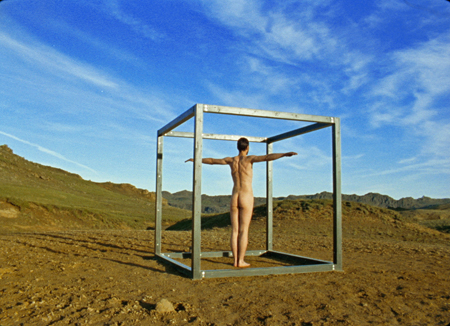"Im Freien" ("In the Open") was shot in a continuous uninterrupted process that lasted for 75 days. We shot one single frame every three minutes for those 75 days in a nature reserve in Iceland. Thus 24 hours of real time got condensed to 20 seconds of projection time and the unedited material of two and a half months became a 23 minutes film.
The film was shot using an analog 16mm Bolex, which was modificated with a digital vieocamera, an electronic motor and a specially built software. Nevertheless the shooting was pure handwork as the software only automatized the triggering.
There where the three of us working the camera in shifts. Circumstances like the frequently challenging weather, technical issues and our general fatigue had a serious impact on our ability to continue. I regularly had to change plans more or less significantly because of unforeseen elements on location. The goal was to let strict ideas meld with effective possibilities. It was a steady learning process.
In contrast to earlier films that mainly focused on the human subject, "Im Freien" is more concentrating on various objects in relation to a pristine presentation of the natural world.
Link to Stefan Grissemanns GERMAN text „Tagnachttag“ for profil-online:
http://www.profil.at/articles/1141/560/314344_s10/kino-tagnachttag
Elaborated Interview about the film by Noah Manos for TIE-Festival
http://albertsackl.com/interview_NoahManos_en.php
Text by Barbara Pichler for Sixpackfilm:
The title „In the Open“ should be taken literally as the camera turns to details of a meager and untouched landscape, which serves as projection surface for exploring the cinematic apparatus, and (de)constructing cinematic space, time, and movement.
Albert Sackl analyzes these connections in the framework of a radical experimental set-up: filming took place with a continuous time-lapse interval of one image every three minutes during the northern summer until the start of autumn. Meeting in a process of analogue linearity, which condenses nearly three months into 23 minutes, are camera and landscape, enormous technical precision, and phenomena such as light, shadows, weather, color, surface textures, and the nights that continually break in and grow continually longer during the process. This encounter of predictable, metrically defined structure and unpredictable natural processes uses the surroundings without becoming lost in them or succumbing to their aesthetic fascination.
With the landscape as a site of both projection and action, it seems inevitable that people will invade this cinematic space. At first cautiously, barely perceptibly, a foot becomes visible for a moment, somewhat later, a fleeting hand. The human, a foreign body in this place, seeks a relationship to the landscape and the camera. This presence becomes continually stronger. Surfacing are also objects: a mirror, a cube, individual elements of an architectural structure, confronting nature with manmade things. And in the end, as a space forms from these diverse objects, the title In the Open seems to revert to its opposite; a space which may well be a projection room, a material reference to the ever defining apparatus: that of the cinema.
(Barbara Pichler)

